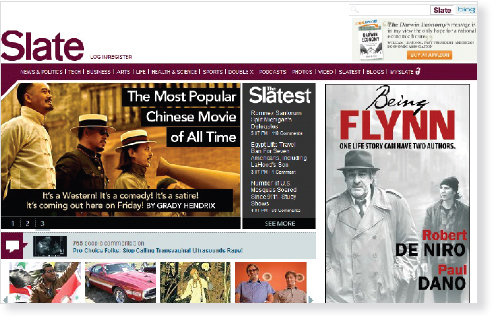Online Magazines
Printed Page 113

VideoCentral  bedfordstmartins.com/ mediaessentials
bedfordstmartins.com/ mediaessentials

Narrowcasting in Magazines
Magazine editors explain the benefits and consequences of narrowcasting.
Discussion: Think of magazines that might be considered a good example of narrowcasting. What makes them a good example, and would you consider them successful? Why or why not?
With nearly two-thirds of Americans linked to a broadband Internet connection, the Internet has become the place where specialized magazines can further extend their reach to their target audiences. Some magazines are now published in both print and online versions. Others have moved to online-only format after their print version ended. Still other magazines—webzines—started up online and have remained there. Respected webzines include Slate (claiming 8 million monthly unique visitors in 2012) and Salon (with 6.4 million monthly unique visitors). These online-only publications have made the Web a legitimate arena for reporting breaking news and encouraging public debate about culture and politics. In 2011, one blog post from a magazine even jump-started a social movement. Inspired by the Arab Spring uprisings in Tunisia and Egypt that were facilitated by the revolutionary use of social media, an anticonsumerist print and online magazine called Adbusters intitiated, mobilized, and orchestrated the Occupy Wall Street protests.
Although many observers initially viewed the Internet as the death knell for print magazines, the industry now embraces it. Numerous magazines that have moved online now carry blogs, original video and audio podcasts, social-networking features, and other interactive components that could never work in print. For example, the online version of Popular Mechanics offers interactive 3-D models for do-it-yourself projects: Readers can use the 3-D models to construct a piece of furniture, for instance, by examining joints and parts from every angle.
In fact, new print magazines often publish with brand-extending synergies in mind. In 1998, for example, cable network ESPN launched ESPN The Magazine. The brand familiarity helped the new print periodical find readers in a segment already crowded with Sports Illustrated, the Sporting News, and dozens of niche sports publications. The magazine also drives cross-promotion of ESPN’s growing business empire, including its cable channels, ESPN radio, the ESPN Web site, ESPN Zone restaurants, and the X Games. As magazines create apps for smartphones and tablets, editorial content will be even more tightly woven with advertising. Readers can now, for example, read Entertainment Weekly’s music recommendations on their devices and then click through to buy the song or album mentioned. The publication gets a cut of the sale, and the reader gets music almost instantly.
As more publications migrate over to digital and mobile platforms, these partnerships have become more important than ever, as have the brand identities of magazines themselves. With so many magazines appearing in a variety of formats, publishers want to create the sense that names like ESPN, Cosmopolitan, or Entertainment Weekly can be trusted all across the media landscape.